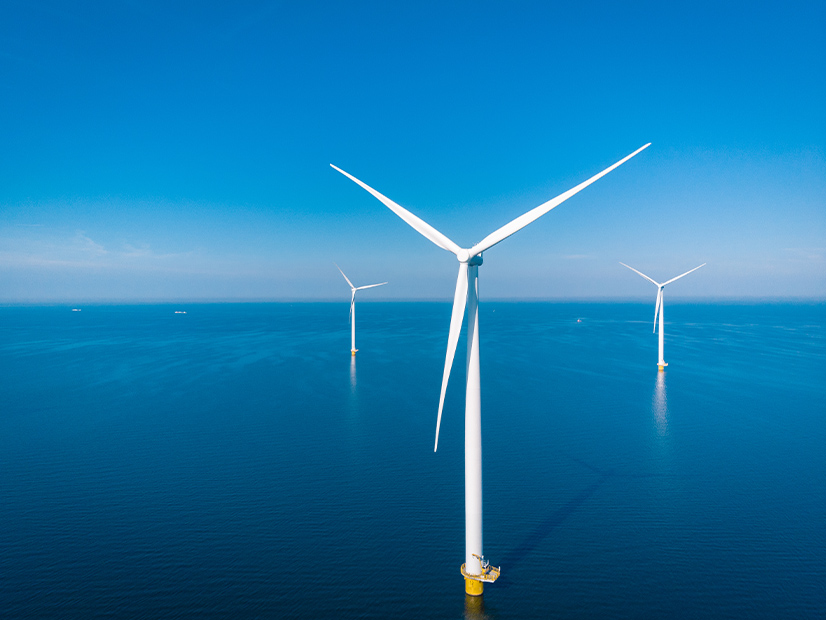
Almost all of New York’s offshore wind portfolio may not be able to move forward under the terms negotiated, developers said Wednesday.
In petitions submitted to the state Public Service Commission, they asked permission to amend their offshore wind renewable energy certificate (OREC) agreements with the New York State Energy Research and Development Authority.
NYSERDA is leading the state’s aggressive climate-protection efforts, which include a goal of 9 GW of offshore wind capacity online by 2035. The projects in question would get New York almost halfway to that goal by 2028.
But as with major wind projects in New England, developers of the New York projects say the cost to create the power generation infrastructure has grown, while the value of the power generated has not.
The petitions submitted Wednesday cover 4,230 MW of the 4,360 MW of offshore wind infrastructure under active development to feed the New York grid: the 924-MW Sunrise Wind project by Ørsted-Eversource, and three projects by the Equinor-bp partnership: Beacon Wind (1,230 MW), Empire Wind 1 (816 MW) and Empire Wind 2 (1,260 MW).
NYSERDA estimates commercial operation dates ranging from 2025 to 2028.
The only other project in New York’s pipeline is the 130-MW South Fork Wind. Construction of the Ørsted-Eversource venture is now underway, and it is expected to start generating power this year.
Six development teams submitted proposals totaling 8 GW in New York’s most recent offshore wind solicitation, which closed in January, but they are not in the pipeline yet. NYSERDA will announce awards this summer and execute contracts this autumn.
This latest solicitation included a provision for inflation-related revision of financial terms. The developers point out that they had no such provision and, as a result, are suffering amid the spiraling costs of recent years.
Sunrise said the negotiated $110.37/MWh payment from NYSERDA for the ORECs it generates is no longer enough.
Sunrise Project Development Director Ryan Chaytors told NetZero Insider via email:
“New York’s most recent solicitation made available to future projects inflation adjustments and interconnection cost-sharing mechanisms that more appropriately reflect today’s market conditions. We believe applying comparable inflation and interconnection cost-sharing adjustments now available to future projects to Sunrise Wind is fair, transparent and sufficient to advance the project.”
Sunrise in its petition notes the remarkable series of events that started soon after it signed its OREC agreement with NYSERDA in October 2019: COVID, decades-high inflation, decades-high interest rates, the worst war in decades, material shortages.
“These unanticipated, extraordinary economic events beyond Sunrise Wind’s control have upended its careful financial and developmental planning for the project. The project’s capital budget has increased from approximately $[X] billion to approximately $[X] billion. Without incorporating inflation and interconnection cost adjustment mechanisms into the OREC agreement, Sunrise Wind believes it would not be able to obtain a final investment decision allowing it to fully construct the project.”
As with other offshore wind projects, the cost of Sunrise is a trade secret, redacted from publicly viewable documents.
Empire and Beacon make a similar plea in their petition: “Despite petitioners’ cost control efforts and advances in permitting and interconnection, these unforeseeable events have substantially reduced the projects’ ability to attract the approximately $[X] investment necessary to support their construction and operation in a globally competitive market.”
The developers say in their petitions that they remain committed to completing the four offshore projects and delivering the promised benefits of the new clean energy source.
In a statement to NetZero Insider on Wednesday, Teddy Muhlfelder, vice president of Equinor Renewables Americas, said Equinor and bp did not take this step lightly but saw no alternative.
“Empire Wind and Beacon Wind remain on track to support thousands of jobs and billions of dollars of economic activity while helping New York meet its renewable energy goals,” he said. “Equinor and bp remain strongly committed to our projects and our partners in New York, and we are optimistic that together we can find a path forward in the weeks and months ahead.”
NYSERDA had limited response Wednesday.
“NYSERDA is aware of the petitions filed with the Public Service Commission and is reviewing the petitions,” a spokesperson said.
Also Wednesday, the trade organization Alliance for Clean Energy New York (ACENY) petitioned PSC for something it has long sought informally: an inflation adjustment mechanism for previously contracted large-scale onshore wind and solar projects in New York, many of which languish in permitting and interconnection processes for years between execution of contract and start of construction.
Here again, ACENY noted that recent contracts have such an adjustment mechanism, but older contracts do not.
The New York Offshore Wind Alliance, which is part of ACENY, represents offshore wind developers working in New York, associated companies, organized labor and environmental groups.
Director Fred Zalcman told NetZero Insider he had not seen Wednesday’s offshore petitions but is familiar with the issues they raise.
“All these projects are subject to the same macroeconomic pressures that we’ve seen manifested in the New England projects,” he said, referring to the SouthCoast and Commonwealth offshore wind projects, which are seeking to exit their Massachusetts power purchase agreements for the same reasons.
“So, it’s not very surprising to see. For better or worse, these projects are subject to fixed-price contracts. We do recognize the need for relief for these projects.”
If NYSERDA agrees to higher strike prices, Zalcman said, the cost will trickle down to ratepayers. But it would be unfortunate, he said, if NYSERDA refused and the nascent industry lost the momentum it has started to build after several years in New York. Offshore wind developers have begun to make progress toward building workforce development pipelines, shoreline infrastructure, and a local manufacturing and supply chain in New York, he added.
The three petitions filed Wednesday are part of PSC Case No. 15-E-0302, the proceeding to implement a large-scale renewable energy program and a clean energy program.
